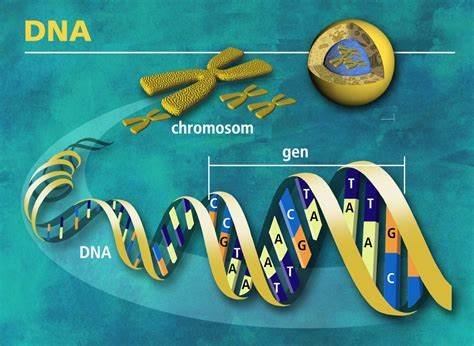DNA (Deoxyribonucleic Acid) is a molecule that carries the genetic instructions essential for the growth, development, functioning, and reproduction of all living organisms. DNA is often referred to as the “blueprint” of life because it contains the instructions for building and maintaining an organism’s cells, tissues, and organs.

1. Structure of DNA
- Double Helix: The structure of DNA is often described as a double helix, which resembles a twisted ladder. The “rails” of the ladder are made up of sugar and phosphate molecules, while the “steps” are pairs of nitrogenous bases.
- Nucleotides: DNA is made up of smaller units called nucleotides, each consisting of three components:
- A phosphate group
- A sugar molecule (deoxyribose)
- A nitrogenous base
- Four Nitrogenous Bases: There are four nitrogenous bases in DNA, and they form base pairs:
- Adenine (A) pairs with Thymine (T)
- Cytosine (C) pairs with Guanine (G)
2. Function of DNA
DNA serves as the instruction manual for building proteins and guiding cell functions. The genetic code is translated into proteins that perform various functions in the body. Here are some key functions:
- Genetic Information Storage: DNA contains the hereditary information passed from one generation to the next.
- Protein Synthesis: DNA provides the code for building proteins, which are essential for most biological processes.
- Transcription: The DNA code is transcribed into messenger RNA (mRNA).
- Translation: The mRNA is used as a template to build proteins through a process that occurs in ribosomes in the cytoplasm.
- Replication: DNA has the ability to replicate itself, ensuring that when cells divide, each new cell gets an identical copy of the genetic material.
3. DNA Replication
DNA replication is a fundamental process that allows a cell to duplicate its DNA before division. Here’s a basic overview:
- Unwinding: The double helix unwinds and separates into two strands.
- Base Pairing: Each single strand of DNA serves as a template for the creation of a complementary strand.
- Formation of New Strands: Enzymes like DNA polymerase help assemble the new strands by adding the complementary nucleotides to each template strand.
- Result: At the end of replication, two identical DNA molecules are formed, each with one original strand and one new strand (semi-conservative replication).
4. Genes and Chromosomes
- Genes: A gene is a segment of DNA that contains the instructions for making a specific protein or set of proteins. Each gene corresponds to a particular trait or function in an organism.
- Chromosomes: DNA is organized into structures called chromosomes. Humans typically have 46 chromosomes (23 pairs), and these chromosomes contain all of the organism’s genes.
- Genome: The entire set of genetic material in an organism, including all its genes, is called the genome. The human genome consists of approximately 3 billion base pairs of DNA.
5. DNA and Heredity
- DNA is the basis for inheritance. During reproduction, offspring inherit DNA from both parents, which determines many of their traits, such as eye color, hair color, and susceptibility to certain diseases.
- Alleles: Different versions of a gene are called alleles. An individual inherits two alleles for each gene—one from each parent. The combination of these alleles contributes to the individual’s traits.
6. Mutations in DNA
- DNA Mutations are changes in the nucleotide sequence of DNA. These can occur naturally during DNA replication or be induced by environmental factors like UV radiation or chemicals.
- Mutations can have various effects:
- Silent Mutations: No change in the protein produced.
- Missense Mutations: A change in one amino acid in the protein, potentially altering its function.
- Nonsense Mutations: A premature stop signal, often leading to a nonfunctional protein.
- Frameshift Mutations: Insertion or deletion of nucleotides, shifting the reading frame and often leading to a dysfunctional protein.
- Mutations are a key factor in evolution and can sometimes lead to genetic disorders or diseases (e.g., sickle cell anemia, cystic fibrosis).
7. Applications of DNA
DNA has many practical applications in modern science and medicine:
- Genetic Testing: DNA testing can be used to determine hereditary conditions, identify genetic disorders, or even establish paternity.
- DNA Fingerprinting: This is used in criminal investigations and ancestry testing by comparing unique sequences in an individual’s DNA.
- Gene Therapy: This involves altering the genes inside a person’s cells to treat or prevent diseases.
- Cloning: Cloning involves creating an organism that is genetically identical to another by copying its DNA.
- Forensics: DNA analysis is used to solve crimes by matching biological samples (e.g., blood, hair) to suspects.
- Biotechnology: DNA is used in the production of medicines (e.g., insulin) through recombinant DNA technology.
8. DNA vs. RNA
While both DNA and RNA are essential for protein production, they have some important differences:
- DNA is double-stranded, stores genetic information, and stays in the nucleus.
- RNA is single-stranded and acts as a messenger that carries the instructions from DNA to the ribosomes, where proteins are made.
There are three main types of RNA:
- mRNA (messenger RNA): Carries genetic information from DNA to the ribosomes for protein synthesis.
- tRNA (transfer RNA): Helps in translating mRNA into a sequence of amino acids.
- rRNA (ribosomal RNA): Makes up part of the ribosome, where proteins are synthesized.
DNA is the molecular foundation of genetics and plays a central role in biology, heredity, and medicine.
